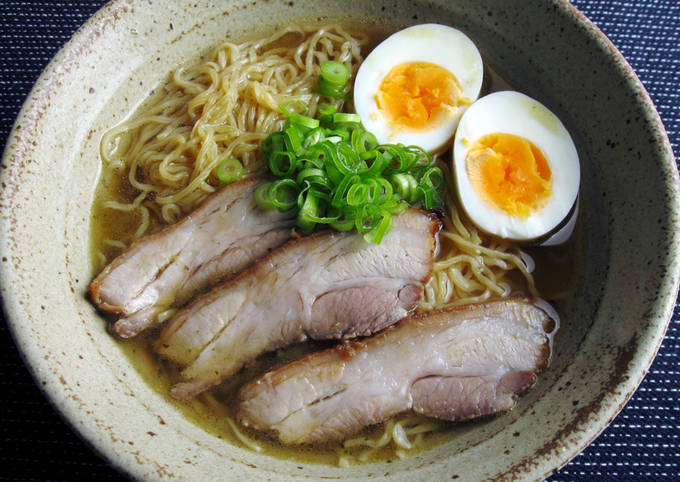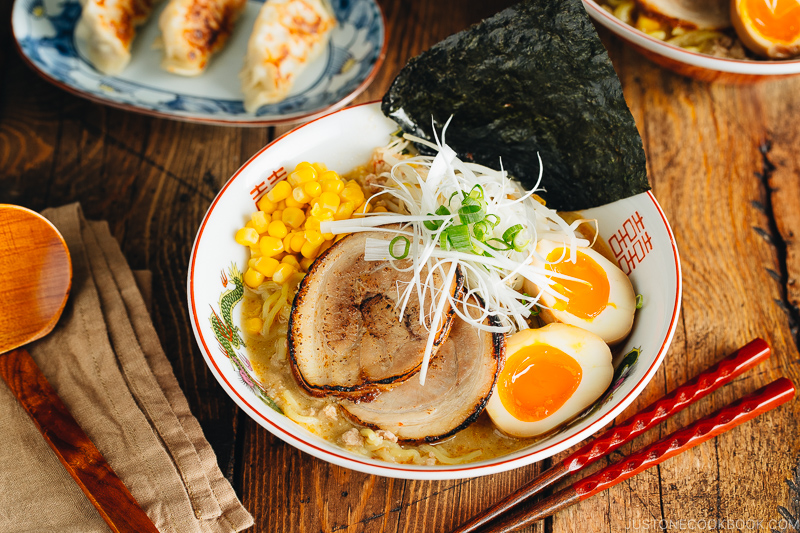Japanese Shoyu Ramen is a beloved and popular noodle dish that has its roots in the bustling streets of Japan. This iconic ramen variety features a flavorful soy sauce-based broth that is rich in umami, paired with springy noodles and a medley of delicious toppings. With its savory and satisfying taste, Shoyu Ramen has gained international acclaim and has become a staple in many ramen shops worldwide. The combination of soy sauce, broth, noodles, and toppings creates a harmonious symphony of flavors that is both comforting and deeply satisfying. Whether you’re a ramen aficionado or a curious food lover, mastering the art of preparing Japanese Shoyu Ramen at home allows you to savor an authentic taste of Japan and experience the magic of this beloved culinary delight. Get ready to embark on a culinary adventure as we dive into the world of Japanese Shoyu Ramen and explore the steps to create a bowlful of umami-infused goodness in your own kitchen.

Japanese Shoyu Ramen Recipe
Ingredients
Equipment
Method
- Take a pan.
- Add in the oil and onions.
- Cook the onions until they become soft and fragrant.
- Add in the chopped garlic and ginger.
- Cook the mixture for a few seconds.
- Add the spices
- Add the sheragi negi into it when the spices are done.
- Mix the ingredients carefully and cover the pan.
- Add the fish cakes and rest of the ingredients except the noodles.
- Let the mixture boil.
- Add the ramen noodles into the soup mixture.
- Let the soup cook for ten to fifteen minutes straight.
- Add shredded nori sheets on top.
- Your dish is ready to be served.
Video
Notes
FAQs
Q1: What is the main difference between Shoyu Ramen and other types of ramen?
A1: Shoyu Ramen is distinguished by its soy sauce-based broth, which gives it a savory and umami-rich flavor. Compared to other types of ramen such as Miso Ramen or Tonkotsu Ramen, Shoyu Ramen has a lighter broth with a distinct soy sauce taste.
Q2: Can I make Shoyu Ramen vegetarian or vegan?
A2: Yes, it is possible to make a vegetarian or vegan version of Shoyu Ramen. Instead of using traditional meat-based broths, you can substitute vegetable broth or mushroom broth to achieve a similar depth of flavor. Additionally, you can replace animal-based toppings with tofu, mushrooms, or other plant-based protein options.
Q3: How long does it take to make Shoyu Ramen from scratch?
A3: The time it takes to make Shoyu Ramen from scratch can vary depending on the recipe and individual cooking skills. Generally, it can take around 1 to 2 hours to prepare the broth, cook the noodles, and assemble the toppings. It’s important to note that the broth often benefits from a longer simmering time to develop its full flavor.
Q4: Can I store leftover Shoyu Ramen?
A4: While it’s best to enjoy Shoyu Ramen fresh, you can store leftovers in the refrigerator for a day or two. Keep the broth, noodles, and toppings separate and store them in airtight containers. When reheating, be sure to cook the noodles separately from the broth to maintain their texture.

Q5: Can I customize the toppings in Shoyu Ramen?
A5: Absolutely! One of the great things about making Shoyu Ramen is the ability to customize the toppings based on personal preferences. Common toppings include sliced pork, soft-boiled eggs, bamboo shoots, nori seaweed, green onions, and mushrooms. Feel free to get creative and add your favorite ingredients to enhance the flavor and texture of your ramen.
Q6: Can I adjust the saltiness of the Shoyu Ramen broth?
A6: Yes, the saltiness of the broth can be adjusted to suit your taste. Start with a smaller amount of soy sauce and gradually add more if needed. You can also dilute the broth with a bit of water or vegetable broth to reduce the saltiness. Taste the broth as you go and make adjustments accordingly.
Q7: Are there gluten-free options for making Shoyu Ramen?
A7: Traditional soy sauce used in Shoyu Ramen contains gluten. However, you can find gluten-free soy sauce alternatives that can be used to create a gluten-free version of Shoyu Ramen. Look for tamari or gluten-free soy sauce brands that are specifically labeled as gluten-free.
Q8: Can I make the noodles from scratch for Shoyu Ramen?
A8: Yes, you can make the noodles from scratch if you prefer a homemade touch. There are various recipes available for making ramen noodles at home using flour, water, and kansui (a type of alkaline water). However, if making noodles from scratch seems daunting, you can also find pre-packaged ramen noodles at grocery stores or Asian markets.
Q9: Can I adjust the spiciness of Shoyu Ramen?
A9: While Shoyu Ramen is typically not very spicy, you can add a touch of heat if desired. Consider adding a small amount of chili oil or hot sauce to the broth during the cooking process, or serve the ramen with a side of chili flakes or sliced fresh chili peppers for those who enjoy some extra heat.
Cooking tips
1. Use quality soy sauce: Since soy sauce is a key ingredient in Shoyu Ramen, opt for a good-quality soy sauce to ensure a robust and authentic flavor. Look for soy sauces labeled as “shoyu” or “soy sauce for ramen” for the best results.
2. Simmer the broth for depth of flavor: To develop a rich and flavorful broth, allow it to simmer for an extended period. This allows the ingredients to release their flavors and infuse the broth with their essence. Aim for at least an hour of simmering time, or longer if possible, for the best results.
3. Prep your toppings in advance: Before assembling your ramen, have all your toppings prepared and ready to go. Slice your green onions, prepare the soft-boiled eggs, and have any other toppings prepped and waiting. This ensures a smooth and efficient assembly process when you’re ready to serve.
4. Cook noodles separately: To prevent your noodles from becoming overly starchy, cook them separately from the broth. Bring a pot of water to a boil and cook the noodles according to the package instructions. Once cooked, drain and rinse them under cold water to stop the cooking process and remove excess starch.
5. Customize your toppings: Feel free to experiment with different toppings to suit your taste preferences. Consider adding ingredients like thinly sliced pork, bean sprouts, corn kernels, menma (fermented bamboo shoots), or even a drizzle of sesame oil for added depth and flavor.

6. Don’t forget the aroma oils: Aromatic oils, such as sesame oil or garlic oil, can elevate the flavor of your Shoyu Ramen. Just a small drizzle of these oils on top of the broth right before serving can add a delightful aroma and depth of flavor to your dish.
7. Serve while hot: Ramen is best enjoyed when it’s piping hot. Assemble your bowls quickly once the noodles and broth are ready to ensure that everything remains hot and appetizing. This helps maintain the ideal texture of the noodles and ensures that all the flavors meld together perfectly.
8. Garnish with a sprinkle of sesame seeds: Consider adding a sprinkle of toasted sesame seeds as a finishing touch to your Shoyu Ramen. This adds a pleasant nutty flavor and an attractive visual element to your bowl.
Remember, making Shoyu Ramen is an art that allows for creativity and personalization. Feel free to adjust the ingredients and techniques to suit your taste preferences and dietary needs. The most important thing is to enjoy the process and savor the delicious results.
Serving Suggestions
Here are some serving suggestions to enhance your Japanese Shoyu Ramen experience:
1. Arrange the toppings: Arrange the cooked noodles in a bowl and carefully arrange the toppings on top. This could include sliced pork, soft-boiled eggs, bamboo shoots, nori seaweed, green onions, and mushrooms. Arrange them attractively to create an appealing presentation.
2. Drizzle with aromatic oils: Just before serving, drizzle a small amount of aromatic oils such as sesame oil or garlic oil over the ramen. These oils add a burst of fragrance and enhance the overall flavor profile.
3. Sprinkle with sesame seeds: For a final touch, sprinkle toasted sesame seeds over the ramen. This not only adds a delightful nutty flavor but also adds visual appeal to the dish.

4. Add some heat: If you enjoy a spicy kick, serve your Shoyu Ramen with a side of chili flakes or sliced fresh chili peppers. Diners can add the desired level of spiciness to their individual bowls.
5. Serve with condiments: Set out a variety of condiments such as soy sauce, chili oil, or vinegar on the table. This allows each person to customize the flavor of their ramen according to their taste preferences.
6. Offer a side of pickles: Serve a side of Japanese pickles, such as takuan (pickled daikon radish) or gari (pickled ginger). These pickles add a tangy and refreshing element to balance the richness of the ramen.
7. Pair with a refreshing beverage: Consider serving Japanese green tea, cold or hot, alongside the ramen to complement the flavors and refresh the palate.
Remember, serving suggestions can be tailored to your personal preferences and creativity. Feel free to experiment and add your own unique touches to create a memorable dining experience with your homemade Shoyu Ramen.








